Putting the squeeze on Lap-Band ads
December 20, 2011
County supervisors squared off Tuesday with promoters of the Lap-Band, featured on billboards all over Southern California but drawing increasing attention from officials concerned that the publicity blitz is obscuring a wide range of medical dangers.
After a series of sharp exchanges with representatives of 1-800 GET THIN, supervisors approved a motion by Supervisors Mark Ridley-Thomas and Zev Yaroslavsky to bring greater scrutiny to Lap-Band marketing and procedures. They directed county staff to, among other things, “develop a plan to identify medical products and services that are being marketed in a dangerously misleading manner.”
The supervisors’ action comes after the U.S. Food and Drug Administration recently sent letters to eight Southern California weight loss clinics and the 1-800 GET THIN marketing firm, warning that the company’s ubiquitous advertisements do not provide enough information about the risks of gastric bypass surgery or about the need to change eating behavior to lose weight over the long term.
“The FDA’s warnings raise significant concerns about the vulnerability of all County residents to these advertisements, particularly those who suffer from morbid obesity and wish to find a cure,” the motion said. “Medical experts and the FDA agree that the Lap-Band procedure is an aggressive treatment for obesity and should only be considered in clinically severe obesity cases.”
Robert Silverman, the president of 1-800 GET THIN, told supervisors that his firm is taking steps to bring its billboards and radio and TV spots into compliance with the FDA requirements. An attorney for the company said its surgery centers “have a better track record than just about anybody else.”
But supervisors were openly frustrated as they tried to find out more about how 1-800 GET THIN operates, in terms of referrals to clinics and responsibility for disclosing risks to potential clients.
“It’s been a long time since a witness or member of the public has come to that table and has obfuscated as consistently and persistently as you have today,” Yaroslavsky told the 1-800 GET THIN representatives. “I did not come here as a person who had any fundamental suspicion one way or the other about what you were doing. I leave here now thinking you are hiding something.”
The FDA’s action was prompted by Dr. Jonathan E. Fielding, the county’s top public health official, who last year asked the agency to investigate whether widespread Lap-Band promotion by 1-800 GET THIN was misleading.
The motion approved by supervisors Tuesday directed the Public Health Department to report back on what it is doing to get the word out about “safe and effective alternative methods to achieve and maintain a healthier weight.”
“There is no panacea for obesity, including the Lap-Band weight loss procedure,” the motion said. “However, there are proven strategies, when sustained over time, which can help people achieve a healthier weight, and decrease the risk for diabetes, heart disease and other chronic diseases.”
The motion also directed the County Counsel to provide legal options on steps the county could take to “ensure truthful advertising of aggressive obesity treatment procedures in unincorporated areas.” And it instructed the Chief Executive Office to pursue legislation to increase supervision and oversight of clinics that perform “aggressive and invasive obesity treatment cosmetic procedures.”
Posted 12/20/11
The new kids on campus
December 1, 2011
 Throughout his 15 years, Mauricio hasn’t had much to celebrate, not with a turbulent family history that has led to a life of foster care and self-doubt. So when the call came, he couldn’t contain himself. “I was jumping up and down,” recalls the impish teenager.
Throughout his 15 years, Mauricio hasn’t had much to celebrate, not with a turbulent family history that has led to a life of foster care and self-doubt. So when the call came, he couldn’t contain himself. “I was jumping up and down,” recalls the impish teenager.
Mauricio had been informed that he’d been picked to participate in an unprecedented summer experiment on the UCLA campus, one that aims to infuse ambition and confidence into a group of kids who rarely go to college mostly because there’s been no one to help them get there.
Mauricio says he packed his suitcase a full month before the start of the intensive, five-week program and arrived so early on the first day that the former sorority house where he and the others would be living was still empty. “I was just so proud,” he says.
In a sense, however, the occasion represented more of a start than a finish. The students will continue to meet monthly on the Westwood campus and, if sufficient funds can be raised, will return in subsequent summers, along with new crops of recruits that will swell the program’s ranks and someday, hopefully, turn them all into full-fledged college students.
On Friday, that pride was shared by plenty of others—but, most importantly, by the 24 inaugural graduates of the First Star UCLA Guardian Scholars Summer Academy, the first such academic program of its kind for foster kids and others under the jurisdiction of child welfare officials. The youngsters, all of whom will be entering 9th grade, were honored during a commencement ceremony highlighted by one girl’s rousing exclamation: “I’m a Bruin now!”
In a sense, however, the occasion represented more of a start than a finish. The students will continue to meet monthly on the Westwood campus and, if sufficient funds can be raised, will return in subsequent summers, along with new crops of recruits that will swell the program’s ranks and someday, hopefully, turn them all into full-fledged college students. (Click here for a video on the program produced by Supervisor Yaroslavsky’s web staff.)
The program’s supporters say they’re determined to shatter the shameful statistics surrounding foster children, huge numbers of whom end up homeless and incarcerated in the years after their 18th birthdays, when they “age out” of the system. Only a fraction of them—an estimated two percent—continue their educations beyond high school.
“You can argue that college is their best possible ladder to leave behind a bad childhood and make it into a happy adulthood and a productive one that will not be a burden on the state, that will be something of high accomplishment,” says media executive Peter Samuelson, a driving force behind the program through his non-profit group First Star, which joined forces with UCLA and the County of Los Angeles.
“There’s nothing the matter with these children. Not one of them,” he says. “All of these kids can go to college. The issue is that nobody ever told them they could. How dumb is that? Who’s failing here, the kids or the grownups?”
The Summer Academy was designed to jump-start the participants’ collegiate careers and expose them to the rigors and culture of university life at a crucial juncture, just as they’re entering high school.
 Each earned four college credits through a challenging mix of classes tailored to their educational, psychological and recreational needs. Those included math, literacy, social media, tai chi, cooking and life skills, where they learned meditation and conflict resolution. In the evenings, they were visited by an impressive series of speakers, including National Hockey League great Luc Robitaille, whose Echoes of Hope charity targets the needs of at-risk Los Angeles foster youth.
Each earned four college credits through a challenging mix of classes tailored to their educational, psychological and recreational needs. Those included math, literacy, social media, tai chi, cooking and life skills, where they learned meditation and conflict resolution. In the evenings, they were visited by an impressive series of speakers, including National Hockey League great Luc Robitaille, whose Echoes of Hope charity targets the needs of at-risk Los Angeles foster youth.
And then there were the field trips to, among other places, Disneyland, Skid Row and celebrity Chef Mario Batali’s restaurant, Mozza, where one teenage girl sheepishly confessed to eating nine slices of the establishment’s famed pizza. (The Batali Foundation also contributed money to the Summer Academy, along with the Stuart Foundation, College Board, Sage Publications and Hasbro Children’s Foundation.)
“It scares you in the right way,” Tiffany, 14, says of the program’s morning-to-night regimen. “You know what you’re being pushed to do. A lot of people say, ‘Oh, I want to go to college.’ But until you actually see college kids and what they do and their level of intelligence, it’s hard to say yes.”
Initially, 30 students were selected for the program. But six boys were sent home in the second week for bad behavior, a wrenching decision for all involved. Still, academy officials had no intention of joining the long line of adults who’ve abandoned or given up on such boundary-pushing kids, a reflection of the program’s commitment to—and understanding of—its charges.
Program leaders have remained in contact with the remorseful teens and have held out the promise that they can participate in the group’s monthly UCLA gatherings and, if all goes well at home and in school, they’ll be able to join next summer’s class of young scholars.
“They’ve been told, ‘You are fine young men.’ They’ve all been given hope and a shining pathway of behavior to get themselves back in,” says Samuelson, who raised $305,000 for the summer academy. “When we get these six young men back into the academy, they will count amongst our greatest successes.”
Day to day, the program is run by a seemingly unflappable educator and former vice principal of an elementary school in a tough New Jersey neighborhood. “I fell in love working with students who felt that nobody else cared about them,” says academy director Wally Kappeler, 37, the father of an eight-week-old son.
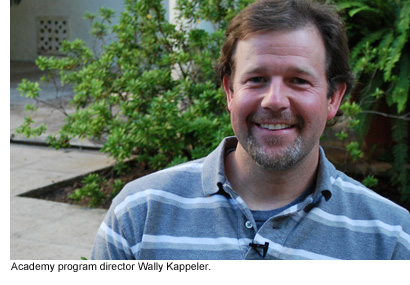 He says that, for him, the biggest surprise of the summer program was how quickly the kids were willing to open up, especially after an evening session when one of them broke the ice and shared the story of his mom’s death. “Here,” Kappeler says, “they have an opportunity to be heard.”
He says that, for him, the biggest surprise of the summer program was how quickly the kids were willing to open up, especially after an evening session when one of them broke the ice and shared the story of his mom’s death. “Here,” Kappeler says, “they have an opportunity to be heard.”
Kappeler says another boy, shy and self conscious about his weight, would mostly keep to himself like “an outcast” until he was given a special daily job of locking a rear door at their three-story Hilgard Avenue house after deliveries by the caterer.
“He felt so proud that this was his responsibility that he volunteered for all kinds of jobs,” Kappeler says. “He volunteered to take the trash out to the dumpster and wipe the tables and make Kool-Aid for the entire group. And it became contagious…It’s amazing the inspiration that he’s been to us, coming out of his shell and taking a leadership role without saying much of anything at all.”
Because of such breakthroughs and the upbeat bonding between the youngsters, it’s easy to forget the circumstances that brought them to UCLA—the abuse and neglect, the revolving placements in new homes and schools, the philosophies of life that have evolved from the sadness of their situations.
Listen, for example, to Eddie, a soft-spoken 15-year-old, who confides: “Too much happiness could actually hurt you. You just need the right amount because I don’t want to get hurt anymore. Right now I’m not really in the mood for situations like love and happiness. I really want to succeed in my life.” Eddie says he’s determined to be the first in his family to attend college.
Or hear what Thalia, 14, has to say as she speaks for the many who’ve been betrayed by parents. “Even if they’ve done something bad to you, they’re still your blood and they’re part of you and you love them no matter what. And you will always forgive them, even though you’re mad at them at the moment. But they’re always going to be in your heart.”
Kappeler says his heart aches when he hears the kids talk like this. “The emotional baggage they’re holding onto is the stuff that most adults would use as an excuse to give up on life.” Instead, Kappeler says the academy is teaching students to harness the power of their narratives through writing, video and social media so they can become more effective advocates for themselves.
“I want them to feel like they can make a difference in this world just by being who they are and getting their story out,” he says, noting that each was given a laptop and video flip-cam to keep.
To guide and inspire the participants along the way, the program was staffed by peer counselors and resident assistants who are UCLA students and, for the most part, former foster youths themselves.
One of was senior Julian Ramirez, 21. As a youngster in San Jose, he endured a home fraught with addiction and violence. “One day my dad would say, ‘Let’s go fishing.’ The next, he’d be beating us with the fishing poles.” Under a mop of dark hair, Ramirez says he’s still got a scar from a concrete slab his father smashed against his head. Child welfare authorities, he says, repeatedly removed him and his siblings from his parents.
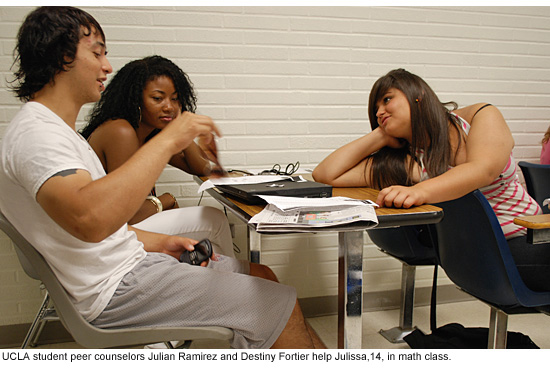 In his senior year of high school, Ramirez says it was “do or die” and he began to excel, achieving a 4.0 and becoming the captain of the wrestling team. He went to a community college in Cupertino—despite several months of homelessness—and then transferred to UCLA, where he joined the UCLA Bruin Guardian Scholars, a campus association of former foster youth. “What mattered to me most,” he says, “was that I wanted to stay on track with my peers. I didn’t want to be slower than them. And I wanted to prove to myself I was capable.”
In his senior year of high school, Ramirez says it was “do or die” and he began to excel, achieving a 4.0 and becoming the captain of the wrestling team. He went to a community college in Cupertino—despite several months of homelessness—and then transferred to UCLA, where he joined the UCLA Bruin Guardian Scholars, a campus association of former foster youth. “What mattered to me most,” he says, “was that I wanted to stay on track with my peers. I didn’t want to be slower than them. And I wanted to prove to myself I was capable.”
He says he hopes that his empathy and success—and that of the other student staffers—proved useful to the young teenagers in the summer program.
“I’ve been through a lot,” he says. “I know how it is to be 14, angry and not have anyone to talk to.”
In fact, the young participants told UCLA researchers late last week that the student mentors were “really impactful for them,” especially in the way “they talked about their journey through foster care,” says Associate Professor Todd Franke of the School of Public Affairs/Social Welfare, who’s conducting a longitudinal study of the students’ progress.
Franke says that, although it’s too soon to say much definitively about the program, there are some encouraging signs, based on a comparison of initial interviews with the teens and another series conducted on the eve of their commencement.
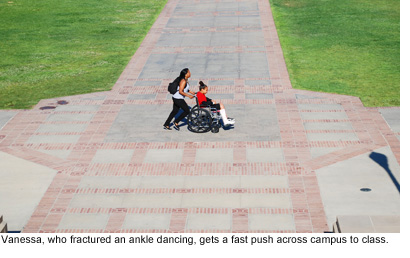 From the beginning, Franke says, virtually all the students said they wanted to go to college. “But in the past five weeks, the vast majority now see it as a much more realistic goal. It moved them further down the continuum to think that this is a real possibility for them.” They got a sense of the workload, learned that they’d likely be eligible for financial aid and came to believe that they’d have a strong campus support group to help get them through the rough patches, according to Franke. “The process,” he says, “was demystified.”
From the beginning, Franke says, virtually all the students said they wanted to go to college. “But in the past five weeks, the vast majority now see it as a much more realistic goal. It moved them further down the continuum to think that this is a real possibility for them.” They got a sense of the workload, learned that they’d likely be eligible for financial aid and came to believe that they’d have a strong campus support group to help get them through the rough patches, according to Franke. “The process,” he says, “was demystified.”
On Friday, commencement day, an assortment of foster parents, legal guardians and relatives gathered around dozens of tables inside UCLA’s Tom Bradley International Hall. There, they heard speeches about the heart and hope of the young Summer Academy participants. Among the officials who addressed the teens and their caregivers was Los Angeles County Supervisor Zev Yaroslavsky, whose office helped facilitate the program through the Department of Children and Family Services.
He told the teenagers that, on some level, he could identify with their struggles. He said his mother died when he was 10 and that his father worked in the evenings, which meant there was no one to help him with homework or keep an eye on him at night.
“The thing that you have that most college students don’t have is that by the time you get ready to come into college, you probably will have gone through the toughest part of your life,” said the supervisor, a UCLA alumnus. “And while you may not appreciate that, you should embrace that experience, treasure that experience, because it’s going to toughen you up. It’s going to make you tough enough to confront whatever comes along your way, when you’re in college and after that.”
After the speeches were done and the two-dozen scholars received their graduation certificates—along with a standing ovation—it was time for them to leave this place of grownup aspirations and youthful good times. There were lots of hugs and tears, even though they’ll all be together again on campus in a month.
“I feel proud but at the same time I feel sad,” explained Mauricio. “I feel like this is my house.”
Video and photos by Supervisor Yaroslavsky’s web staff.
Posted 8/7/11
At probation, the new powers that be
October 26, 2011
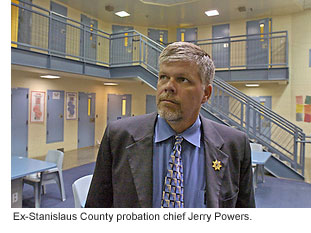 Jerry Powers could have predicted as much. The first paragraph of the Los Angeles Daily News story announcing his hiring Tuesday by the Board of Supervisors began with the phrase, “Los Angeles County’s troubled Probation Department has a new chief.”
Jerry Powers could have predicted as much. The first paragraph of the Los Angeles Daily News story announcing his hiring Tuesday by the Board of Supervisors began with the phrase, “Los Angeles County’s troubled Probation Department has a new chief.”
“Every news report, it’s the same thing, ‘troubled, troubled, troubled,” Powers was saying just the other day. “I was joking with the board that my cards will have my name, title and ‘Troubled L.A. County Probation Department.’ ”
Powers, of course, knows that reporters are unlikely to abandon the descriptive shorthand until he gives them a new story line, a daunting challenge for an agency that has, among many other things, come under intense Justice Department scrutiny for failures in its juvenile camps, severe budgeting lapses and considerable churn at the top. Powers’ predecessor is leaving after only 18 months on the job.
“We’ve got some flaws, and some work to do,” Powers acknowledges. “That’s been well documented. But I’m convinced we can fix that. This department can be a leader in the field again.”
Powers, who’ll begin work on December 5 and earn an annual salary of $255,000, is likely to experience some culture shock, not only because of the enormity of the issues confronting the department but because of its sheer bulk.
He’ll arrive here after a well respected career in Stanislaus Countyin the northern Central Valley, where he’s been chief probation officer since 2002. There, the department’s 250 employees oversee 7,000 adults and 900 juveniles. Its budget is $25 million.
Those numbers, however, represent a fraction of what Powers will confront inLos AngelesCounty, where 6,200 staffers supervise more than 50,000 adults and 20,000 juveniles. Its budget is $716 million.
What’s more, no probation department in Californiawill feel a greater impact from the state’s new criminal justice “realignment” law, which transfers to the counties the responsibility of supervising newly-released prison inmates who’d been serving sentences for non-violent, non-serious, non-sexual crimes.
In Los Angeles County, these paroled inmates—many with prior histories of serious and violent crimes—are predicted to number 9,000 by June.
Asked how he’ll make the adjustment from a relatively small operation to such a huge one, Powers says “that’s the No. 1 question.” But he’s convinced “it’s strictly a leadership issue,” whether you’re responsible for 250 employees or 2,500. And that means “being visible, holding people accountable and putting people in the right places to succeed.”
Powers, who is president of California’s association of probation chiefs—and was a reported finalist to become Stanislaus County’s chief executive officer until taking the L.A. job—describes himself as a “collaborative” and “flexible” leader, “who’s pretty sure about what I want and what I don’t want.”
“But at the end of the day,” he says, “I’m ultimately responsible, and we’re [the staff] going to move in the same direction. And if you’re not interested in pulling in the same direction, then we’ll get people who are. The vast majority of people here do not want to work for a ‘troubled’ department. They want to be proud of who they work for and know that what they do is of value to the community.”
Posted 10/26/11
Experts onboard with Westside Subway
October 19, 2011
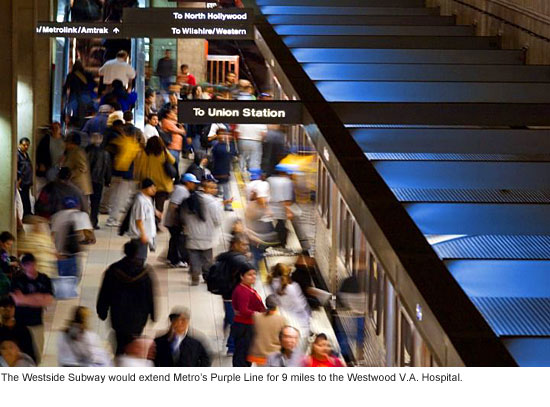 A key stretch of the Westside Subway could safely be built under the Beverly Hills High School campus, a high-profile panel of experts told a Metro committee Wednesday after reviewing the results of extensive testing for earthquake hazards, vibration and noise, subterranean methane gas and abandoned oil wells.
A key stretch of the Westside Subway could safely be built under the Beverly Hills High School campus, a high-profile panel of experts told a Metro committee Wednesday after reviewing the results of extensive testing for earthquake hazards, vibration and noise, subterranean methane gas and abandoned oil wells.
On all counts, the experts said, subway tunneling under the school could be accomplished without endangering students or others, without undermining the school’s role as an emergency evacuation center and without interfering with plans to one day remodel the campus to include an underground parking garage or other buildings.
Significantly, the experts also concluded that it would be dangerous to build the Century City subway station on Santa Monica Boulevard, one of two locations under consideration, because of the presence of two active earthquake faults, one running parallel to Santa Monica Boulevard. The other potential Century City station site—at Constellation Boulevard and Avenue of the Stars—is not on an active fault and thus remains a viable option for a station, the experts said.
The experts’ testimony before the Metro board’s Planning and Programming Committee could play a pivotal role in the subway’s planning. While the committee members took no positions Wednesday on what they heard during the briefing, the question of where to place the Century City station has been a matter of heated debate, with many in Beverly Hills vigorously opposing the Constellation station because the route to get there would pass under their city’s high school campus.
Those testifying included not just experts from project’s tunneling advisory panel but also members of a specially-convened group of prominent independent reviewers brought in to assess the soundness of the research.
One of the independent experts, seismologist Lucy Jones of the U.S. Geological Survey and Caltech, said her group “completely agreed with” the conclusion that “the Santa Monica Boulevard station sites would be dangerous to build on.”
At the same time, she emphasized that it is possible to safely to build tunnels through earthquake zones by having the tunnels cross the faults at a sharply perpendicular angle. That would be the case in the route involving the Constellation station.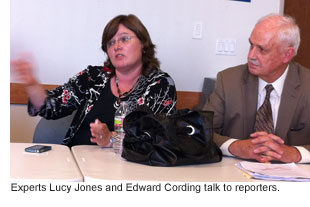
“To build a subway in Los Angeles, you can’t avoid earthquakes,” Jones said. “They’re going to be here. And you cannot avoid faults. You can, however, build effectively around faults and it’s been done in a lot of locations: in Los Angeles, in San Francisco, Mexico City…What you’ve got to try to do is to put your tunnels at a high angle, close to perpendicular to the faults, and avoid ever putting a station in a fault.”
Also testifying was consulting earthquake geologist James Dolan, a professor of earth sciences at USC who is among the project’s fault experts. (For a full list of the experts, click here; their full reports are now posted here, along with a letter on their findings.)
Supervisor Zev Yaroslavsky, a member of the Metro committee, said bringing in an independent expert peer review panel made up of “people that the public knows and recognizes” was important and, “given the rhetoric that’s been freely flowing out of Beverly Hills,” could help alleviate concerns about the impartiality of the scientific research.
And he stressed the significance of what’s at stake.
“This has to be a decision, when we make it, that has to be based on science and facts, not based on what we feel or think based on our gut,” Yaroslavsky said. “This is a very expensive decision that we’re going to make. It’s a profound decision both in terms of planning and in terms of finances. If we build a station in the wrong place and three months after we build the station we have an earthquake and the station is destroyed and people are killed, we have an issue.”
Beverly Hills Mayor Barry Brucker attended the committee meeting and said afterward that he found the presentation impressive. Still, he said it is important to have the city’s own experts review the scientific reports, particularly when it comes to the finding of no active faults at the Constellation Boulevard site.
“I’m not skeptical of the science but we are going to have our consultants get all that data,” Brucker said. “It’s just good prudent governance to have a second independent peer review that we commission.”
In a statement, Beverly Hills Unified School District president Lisa Korbatov said Metro had opened a “veritable Pandora’s box” with the seismic data presentation, and said the agency had held on to the data for too long without sharing it with the public.
Metro CEO Art Leahy responded with his own statement Thursday morning, saying that key information was made public soon after it was first analyzed. “Within just the past few months,” Leahy said, “our technical experts have located precisely long-suspected fault features. Their work was reviewed and confirmed yesterday by independent reviewers I engaged six weeks ago.”
Supervisor Michael D. Antonovich, also a member of the Metro committee, asked during the meeting how much the experts were being paid. Metro officials said they were unable to immediately provide the figure but said it was part of the project’s overall budget. After the meeting, Jones said that, as a U.S. government employee, she was not being compensated for her work but was doing it as part of her job.
The Metro board last year approved the subway project’s draft environmental impact statement/report, with a proposed route that included the two possible locations for the subway’s Century City station.
At the same time, the board approved a motion by Yaroslavsky calling for a thorough review of all the potential risks around the high school and throughout West Beverly Hills, Century City and Westwood.
Wednesday’s oral report to the board committee represents the first public accounting of what the experts found. Their assessment will be included in the project’s final environmental impact statement/report, expected to be released this winter.
After a final round of public comments, Metro’s board is expected to vote on the project early next year. As currently envisioned, the Westside Subway would be a 9-mile extension of Metro’s Purple Line, with seven new stations ending at the Westwood V.A. Hospital.
Some construction could begin as early as 2013. If completed by 2022, the project could cost an estimated $5.3 billion. Funding will come in part from Measure R, the ½-cent sales tax approved by county voters in 2008, but federal money will also be required.
Here, based on testimony and executive summaries posted Wednesday, are some of the experts’ conclusions:
There is “no reasonable tunnel alignment” that could avoid passing under any structures on the Beverly Hills High School campus. (A presentation during the meeting showed that the tunnel would only run under Building B of the high school’s south wing, not the gym/pool building.) The depth of the tunnel—55 to 70 feet below the surface—would allow space for a future structure such as an underground parking lot to be built above it, the summary said.
Vibration from subway trains traveling under the campus would be 64 decibels or less—below the federal threshold of 72 to 75 decibels. The noise level would be no greater than 33 decibels, less than the federal standard of 35-40 decibels.
Advances in tunneling—notably through the use of pressurized closed-face tunnel boring machines—will minimize the risk of ground settlement during the project and were successfully used in building the Metro Gold Line’s Eastside Extension, the summary said.
Tunnels would be built to “maximum design earthquake” standards using the closed-face tunnel boring machines and special water-tight and gas-tight liners. “Since the tunnels will be designed to not collapse during an earthquake, the tunnels will affect neither the threat to buildings above active faults during an earthquake nor the severity of the shaking,” the executive summary said. Thus, there would be no effect on the high school’s role as an emergency evacuation center.
As for abandoned oil wells on the campus, magnetic testing found “one anomaly” on the west edge of the school’s lacrosse field that may or may not be the metal casing from an abandoned well. Hi-tech advance testing would enable construction to safely work around the obstruction if it turns out to be an inactive well, the report said. It also noted that an abandoned oil well that appears on maps of the area is located under a parking structure on Century Park East, not under the high school.
Almost the entire project is located within the city of Los Angeles’ “methane zone,” and testing for methane and hydrogen sulfide gas around Constellation Boulevard found concentrations that “could be explosive under unfavorable conditions.”
However, advances in machinery, technology and regulation—and decades of tunneling industry experience—have made it possible to tunnel safely through gassy ground. The report also noted that higher levels had been found, and successfully overcome, during construction of the Red Line in downtown Los Angeles.
Overall, the summary said, “The project is not expected to pose new threats to the students, faculty or community as a result of its construction and operation.”
Posted 10/19/11
It’s not easy being Mom
May 5, 2011
Mother’s Day means flowers, candy, hugs and a full court press at Hallmark. But for many new moms in Los Angeles, becoming a mother is no brunch at the Ritz.
Data from the latest “Los Angeles Mommy and Baby Survey,” published by the county Department of Public Health earlier this year, show that despite some positive news on breast-feeding, prenatal care and post-delivery checkups, there’s trouble in Momville.
From depression to dental woes, unplanned pregnancies to prenatal obesity, the survey offers what can only be termed a mother lode of insights into new motherhood in L.A.
First, the good news. “Over 90% of the women in L.A. County receive prenatal care, which is spectacular compared to other parts of the country,” said Dr. Diana Ramos, the county’s director of reproductive health, who noted that Medi-Cal has helped to ensure that low-income women in California are covered during pregnancy. Also, 85.2% of the mothers surveyed had breastfed their babies and 98.3% took their newborn in for a well-baby check-up.
Now for the not-so-good.
 The countywide survey, which canvassed 6,264 new mothers who gave birth in 2007, found that 58.1% of new mothers surveyed said they were at least a little depressed after giving birth, and 19.9% said they had been depressed for a period of two weeks or more during their pregnancies.
The countywide survey, which canvassed 6,264 new mothers who gave birth in 2007, found that 58.1% of new mothers surveyed said they were at least a little depressed after giving birth, and 19.9% said they had been depressed for a period of two weeks or more during their pregnancies.
“One of the things that is quite startling is the number of women who experience depression,” said Cynthia Harding, director of Maternal, Child and Adolescent Health Programs for the public health department, which produced the survey.
“It says that we need to provide more social support,” Harding said. “Pregnancy is a time of joy, and if you’re not feeling the joy, you might feel ‘What’s wrong with me?’”
To that end, a multifaceted push is on to increase awareness of maternal depression, reduce the stigma and train health care and other providers to better recognize the symptoms. This brochure is being distributed this month to new mothers in all hospitals across the county.
“It’s a very, very vulnerable time,” said Caron Post, director of the L.A. County Perinatal Mental Health Task Force, which is spearheading the “Speak Up When You’re Down” campaign with the Department of Public Health. “Mothers put on a happy face. It’s taboo to be depressed and be a mother.”
Obesity is also a big concern.
More than 38% of the mothers surveyed were overweight or obese before getting pregnant, and more than a quarter said they didn’t exercise during pregnancy.
“If there was any one call to action, it would be obesity. It’s one of the big risk factors in maternal mortality,” Dr. Ramos said. “Yes, we all know there’s an obesity issue. But I don’t think we’re doing enough to give directive advice [on keeping weight down] to reproductive age women.”
There’s also room for improvement when it comes to pre-pregnancy preparedness.
For instance, 53.4% of the new moms surveyed said their pregnancies had been unwanted or “mistimed,” and 34.1% said their husband or partner shared those views.
 What’s more, 70.7% received no preconception health counseling and 54.4% didn’t know about the importance of taking folic acid supplements before and during pregnancy. And 9.6% smoked in the six months before becoming pregnant.
What’s more, 70.7% received no preconception health counseling and 54.4% didn’t know about the importance of taking folic acid supplements before and during pregnancy. And 9.6% smoked in the six months before becoming pregnant.
Not exercising during pregnancy was by far the most common “risk behavior,” reported by 28.6% of those surveyed. But other risks showed up, too, including drinking alcohol (10.5%), exposure to second-hand smoke (6.3%), smoking (2.6%) and using illegal drugs (2.4%).
In the 3rd District, women who participated in the written survey reported high rates of breastfeeding and well-baby check-ups. They were the least likely to have been overweight prior to pregnancy—and the most likely to have received fertility treatment.
They also were the likeliest to drink alcohol during their pregnancies, 12.4% compared to 10.5% countywide. Any level of drinking during pregnancy is of concern to public health officials. “It may be two or three weeks before you realize you’re pregnant. If you want to get pregnant, stop drinking ahead of time,” said county maternal programs director Harding.
Another painful finding: dental distress.
Nearly 19% of those surveyed (21% in the 3rd District) said they’d experienced periodontal disease during pregnancy. Many women can’t find a dentist who’ll treat them, especially during pregnancy, while others are fearful and put off going until the pain is unbearable, advocates said. In either case, tooth and gum infections can present a serious medical risk for mother and fetus when bacteria enter the bloodstream.
The survey is part of the Los Angeles Mommy and Baby Project, which was launched following an increase in infant deaths in the Antelope Valley, mostly among African Americans, from 1999 to 2002. After an initial 2004 pilot survey in the Antelope Valley, the project was expanded countywide in 2005.
A new survey of women who gave birth in 2010 is currently underway, and is expected to capture stresses inflicted by the current economic downturn.
“We are seeing more and more patients who have lost their health insurance but don’t qualify for any low-income programs,” said Debra Farmer, president and CEO of the Westside Family Health Center in Santa Monica.
Even among the 2007 moms, 36.7% said they had no insurance, 22.4% reported stress over unpaid bills, 13.8% were stressed out over job loss experienced by their husband or partner, and 11.6% over losing their own job.
There are concerns that as California moves to implement health reform—and to cope with a drastic budget situation—that cutbacks will diminish the level of maternity services available to those who need them most.
“I think a lot of what has been there in the past is eroding because of the economic situation and the state cutbacks,” said Lynn Kersey, executive director of Los Angeles-based Maternal and Child Health Access. “What’s going to happen during health reform is of extreme interest.”
Keep that resolution now – ask us how!
January 6, 2011

Quit smoking! Stop drinking! Earn more! Owe less! Get that degree while shedding 10 pounds of belly fat!
If these are among your New Year’s resolutions, we’d suggest one more: buyer beware. For as surely as the ball drops in Times Square, scammers are gearing up to take advantage of your good intentions.
So how can you maintain your resolve in 2011 while steering clear of pitfalls? We asked Rigo Reyes, acting director of the county’s Department of Consumer Affairs, whose experts looked at some popular resolutions and offered these tips.
 Get healthy. “We see a lot of weight-loss programs,” says Reyes, whose team recently has been forwarding complaints and inquiries to the California Medical Board about lap band surgery. But that’s just one get-healthy-quick pitch among many. Faith healers in bogus farmacias prey on Spanish-speaking consumers who want to quit drinking or smoking or overeating. And every year, Reyes says, he hears from couch potatoes who bought sales pitches from some gyms without actually reading the high-priced contracts. “People need to read the fine print and not just believe promises,” says Reyes. Short cuts are imaginary and costly. A walk around the block, on the other hand, is free.
Get healthy. “We see a lot of weight-loss programs,” says Reyes, whose team recently has been forwarding complaints and inquiries to the California Medical Board about lap band surgery. But that’s just one get-healthy-quick pitch among many. Faith healers in bogus farmacias prey on Spanish-speaking consumers who want to quit drinking or smoking or overeating. And every year, Reyes says, he hears from couch potatoes who bought sales pitches from some gyms without actually reading the high-priced contracts. “People need to read the fine print and not just believe promises,” says Reyes. Short cuts are imaginary and costly. A walk around the block, on the other hand, is free.
 Get out of debt. “This is a top priority for a lot of people in this economy,” says Reyes. But beware of credit repair scams and offers of foreclosure assistance and debt consolidation. No one can legally remove accurate information from a credit report, and if the information is inaccurate, you can get it removed for nothing. If you’re having foreclosure troubles, deal directly with the bank or get help from a HUD-approved nonprofit—don’t waste money on for-profit intermediaries. As for debt consolidation offers, Reyes says many leave consumers with high fees, unpaid debts and worse credit. Scams such as these have become so predatory that new laws have been passed to address them. Up-front fees are now illegal for credit repair, loan modification and foreclosure assistance in California. A new federal telemarketing rule also prohibits them for debt consolidation services offered through phone sales. If you really need help, Reyes says, contact the Consumer Affairs Department at (800) 593-8222 or (213) 974-1452: “We’ll help you out for free.”
Get out of debt. “This is a top priority for a lot of people in this economy,” says Reyes. But beware of credit repair scams and offers of foreclosure assistance and debt consolidation. No one can legally remove accurate information from a credit report, and if the information is inaccurate, you can get it removed for nothing. If you’re having foreclosure troubles, deal directly with the bank or get help from a HUD-approved nonprofit—don’t waste money on for-profit intermediaries. As for debt consolidation offers, Reyes says many leave consumers with high fees, unpaid debts and worse credit. Scams such as these have become so predatory that new laws have been passed to address them. Up-front fees are now illegal for credit repair, loan modification and foreclosure assistance in California. A new federal telemarketing rule also prohibits them for debt consolidation services offered through phone sales. If you really need help, Reyes says, contact the Consumer Affairs Department at (800) 593-8222 or (213) 974-1452: “We’ll help you out for free.”
 Get a job. If the jobless rate is any indication, millions of Californians share this resolution. But employment scams are already worsening life for the desperate. “A lot of them are phishing schemes and bogus mystery shopper programs—you get an email from people claiming to be ‘recruiters’ who can get you a job if you just give them your information, which then leaves you vulnerable to identity theft.” Some of these job scammers go further. They send bogus checks to people to purportedly finance their “start-up” costs. The victims are told to deposit the checks and wire back a portion to third parties. Because the law requires banks to make the funds from the deposited check available before the check completely clears, the scammers get away with the money, which the bank will try to collect from you.
Get a job. If the jobless rate is any indication, millions of Californians share this resolution. But employment scams are already worsening life for the desperate. “A lot of them are phishing schemes and bogus mystery shopper programs—you get an email from people claiming to be ‘recruiters’ who can get you a job if you just give them your information, which then leaves you vulnerable to identity theft.” Some of these job scammers go further. They send bogus checks to people to purportedly finance their “start-up” costs. The victims are told to deposit the checks and wire back a portion to third parties. Because the law requires banks to make the funds from the deposited check available before the check completely clears, the scammers get away with the money, which the bank will try to collect from you.
 Get a degree. Great resolution, but only if you can use the diploma, so look out for unaccredited and for-profit schools. “The private post-secondary bureau in the state Department of Consumer Affairs used to license these schools, but the legislation authorizing it was allowed to sunset three years ago,” says Reyes. “People are trying to re-establish it, but in the meantime, there has been a free-for-all.” If you want to take classes or get job training, he says, apply to an accredited university, enroll at a community college or check out adult education programs at your local high school. “The Evans Adult School, which is part of the Los Angeles Unified School District, has a very comprehensive program,” says Reyes, “and you don’t have to pay anything but $5 for a student I.D.”
Get a degree. Great resolution, but only if you can use the diploma, so look out for unaccredited and for-profit schools. “The private post-secondary bureau in the state Department of Consumer Affairs used to license these schools, but the legislation authorizing it was allowed to sunset three years ago,” says Reyes. “People are trying to re-establish it, but in the meantime, there has been a free-for-all.” If you want to take classes or get job training, he says, apply to an accredited university, enroll at a community college or check out adult education programs at your local high school. “The Evans Adult School, which is part of the Los Angeles Unified School District, has a very comprehensive program,” says Reyes, “and you don’t have to pay anything but $5 for a student I.D.”
Posted 12/05/11






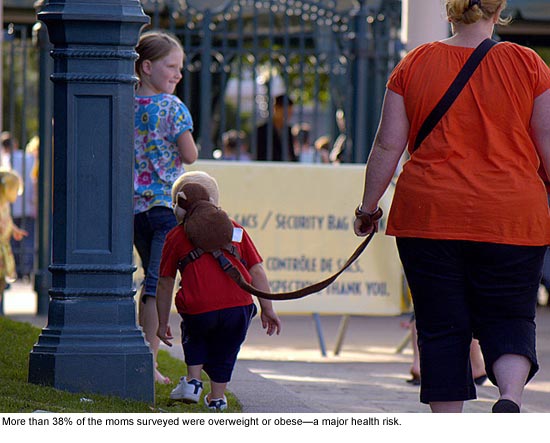







 405 bridge work causes a stink
405 bridge work causes a stink

